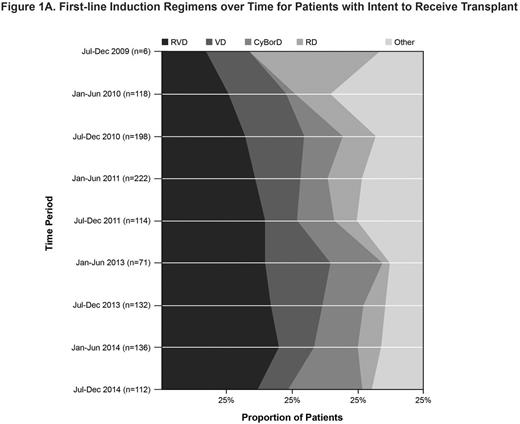Abstract
Introduction: Between 2009 and 2015, use of novel therapies (immunomodulating drugs and proteasome inhibitors) in multiple myeloma (MM) increased. Regimens initiated during this time frame may help project near-term future treatment patterns. Connect® MM is the first and largest prospective, observational, US-based, multicenter disease registry designed to characterize treatment patterns and outcomes for patients (pts) with newly diagnosed MM (NDMM). Pts with NDMM were enrolled in 2 sequential cohorts from Sep 2009 to Apr 2016. This noninterventional registry did not prescribe or limit therapy choices. Study sites represented all census regions, with 89% and 11% split between community and academic sites, respectively. This allowed a reasonable generalizability to patterns for the US.
Methods: Connect® MM enrollment was initiated in Sep 2009 at 250 community and academic sites. Pts were enrolled within 2 months of diagnosis. Cohort 1 enrolled 1493 NDMM pts from Sep 2009 to Dec 2011, and Cohort 2 enrolled 1518 NDMM pts from Dec 2012 to Apr 2016. Data were collected at a baseline visit and quarterly visits thereafter until death or discontinuation. The current analysis was conducted for the population of treated pts (N=2848) as of May 2016. This study examined recorded treatment choice of first-line regimen, maintenance therapy, and second-line regimen in 6-month intervals. Trends in regimens were graphically represented using "Tepee" plots (Srinivasan, Shankar. Resource Tepee. Patent US 7,495,673 B1. 24 Feb 2009). Briefly, all pts who initiated treatment during each 6-month interval are represented horizontally, with each horizontal line indicating 100% of all treatment used in that period. The regimens are represented by gray shading with wider bands signifying the more frequently used regimens at each time interval.
Results: Median follow‐up for all pts was 39.3 months (0.03‐78.4) in Cohort 1 and 15.4 months (0.2-40.1) in Cohort 2. For the treated population, the median age was 67 years (range 24‐94), 58% were male, 83% were white, and 38% of those reporting International Staging System stage had stage III MM. By US geographical region, 329 (11.6%) pts were from the Northeast, 1036 (36.4%) from the Midwest, 1117 (39.2%) from the South, 360 (12.6%) from the West, 4 (0.1%) from Puerto Rico, and 2 missing (0.05%). Most pts (2285; 80.2%) were from community sites, and 397 (13.9%) were from academic sites with the remaining from government sites. A total of 1416 (47.4%) reported an intent to transplant (stem cell transplant [SCT]) at the initiation of therapy. A total of 666 (25.8%) have progressed and entered second line. Tepee plots of treatment patterns for start of induction for those pts with and without SCT intent are provided in Figure 1A and 1B, respectively. The year 2012 does not feature in these induction plots, as this period corresponds to a time when pts were not enrolled-Cohort 1 had been completed and Cohort 2 had not yet opened. The 4 most common induction regimens for SCT intent, from left to right, in order of decreasing frequency of use, were lenalidomide (R), bortezomib (V), dexamethasone (D) combined (RVD); VD; cyclophosphamide plus VD (CyBorD); and RD. The 5 most common induction regimens for those without SCT intent, from left to right, in order of decreasing frequency of use, were VD, RD, RVD, CyBorD, and V. Triplet therapy in first-line induction pts increased in frequency from 2009 to 2014. The 4 most frequent maintenance regimens for those with SCT intent were R monotherapy, V monotherapy, RD, and RVD. The 4 most common maintenance regimens for pts who did not intend to receive SCT were R monotherapy, RD, VD, and V monotherapy. The most prevalent regimens in the second line were VD, RD, V, and RVD. Additional graphs including treatment patterns by age group (≤ 70 vs > 70 years) and maintenance by conduct of first-line SCT will be presented.
Conclusions: Our work utilizes Tepee plots to outline induction and maintenance treatment patterns over time, for both SCT and non-SCT intent pts, using the largest, prospective, noninterventional registry study in the US. Triplet therapy use increased in the time period studied, with RVD being the most frequently used triplet for pts with or without SCT intent. The most common maintenance regimens included R as monotherapy or in combination.
Rifkin:Takeda: Membership on an entity's Board of Directors or advisory committees; Celgene: Membership on an entity's Board of Directors or advisory committees; Amgen/ONYX: Membership on an entity's Board of Directors or advisory committees. Abonour:Celgene: Membership on an entity's Board of Directors or advisory committees. Durie:Amgen: Consultancy; Janssen: Consultancy; Takeda: Consultancy. Gasparetto:Celgene: Consultancy, Membership on an entity's Board of Directors or advisory committees, Research Funding; Takeda: Consultancy; Janssen: Honoraria; Bristol-Myers Squibb: Honoraria. Jagannath:Bristol-Myers Squibb: Consultancy; Celgene: Consultancy; Merck: Consultancy. Terebelo:Celgene: Membership on an entity's Board of Directors or advisory committees. Toomey:Celgene: Consultancy. Kitali:Celgene: Employment, Equity Ownership. Zafar:Celgene: Employment. Srinivasan:Celgene: Employment; Individual Patent: Patents & Royalties: US7,495,673B1 Used for MM-Connect Treatment Patterns Abstract.. Hardin:Celgene: Consultancy, Membership on an entity's Board of Directors or advisory committees.
Author notes
Asterisk with author names denotes non-ASH members.



This feature is available to Subscribers Only
Sign In or Create an Account Close Modal